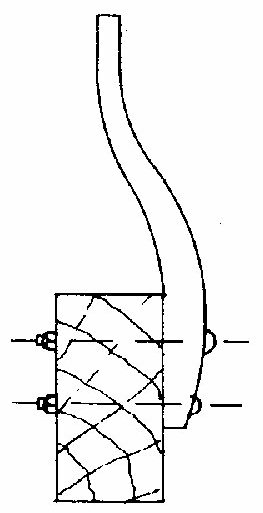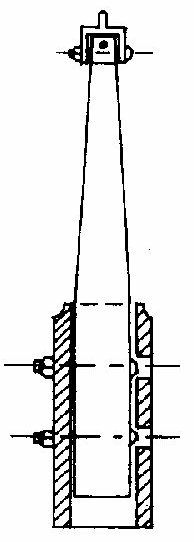
Curved stay (on timber headstock)

Straight stay (on timber headstock)

Hastings stay (on socketed metal headstock)
The Tower Handbook
Properly seasoned ash. This is a straight grained timber with no knots and the ideal timber for the job. Beech is less durable than ash.
Tricky one this. Stays fitted in the sockets of metal headstocks are always straight, but stays bolted to the side of a headstock are sometimes curved. The general idea of the curve was to bring the tip in line with the centre of the headstock so it would make contact with the slider more evenly. Bell hangers nowadays install straight stays because they are much easier to make. They fit the runner board and slider pin off centre to align with the offset stay.
 Curved stay (on timber headstock) |
 Straight stay (on timber headstock) |
 Hastings stay (on socketed metal headstock) |
Note that the bolts holding socket fitted stays must pass through the holes on one side of the socket to hold the stay firmly against the opposite face.
This depends on how tough your stays are, how many learners you have and how likely they are to bang the stays. If you have a lot of learners and you teach them on the same bell(s) all the time and they frequently bang the stays, it would be as well to check the stays on these bells on a weekly basis (when you remove the clapper silencers, for instance). Other bells should be checked every month or two. Watch out for cracks with the grain or where the bolts go through the stays. If you have metal headstocks with stays in sockets in the headstock, keep an eye on the stay at the point where it enters the headstock, since the greatest stress is just inside the socket. Make sure the stay securing bolts are tight.
Generally speaking, no. A stay provides a safety valve for heavy-handed ringers (or learners). Stays are intended to break if too much force is used. If you substitute a stronger material you may do irreparable damage to other less easily replaceable parts like the bearings. But do check that the timber you are using is suitable. Stays made of a brittle wood will break but stays made of a supple wood will absorb some of the impact. Also check that the pattern you started from wasn't too flimsy. If in doubt, get advice.
An aside may be in order here: stays should not keep breaking if pupils are being taught correctly. Even learners should only occasionally bump the stay. Perhaps you should change your instructor rather than the stay!
It is one in which the traditional slider is replaced by a fixed rail mounted on the frame and a small moveable toggle or 'dingle' on the end of a short, straight stay. The dingle is free to rock to and fro parallel to the headstock (at right angles to the travel of the end of the stay). When the bell nears the balance the toggle engages with the metal rail (shaped like an elongated S). This is secured to the lower part of the frame below the bell near where the runner board would normally be. There is no slider. The toggle is deflected along one side of the S at handstroke and along the other at back. At the far end of the S on each side is a wooden stop against which the toggle rests to support the bell when stood.
Hastings stays were invented in the last quarter of the nineteenth century, at a time when most bells were hung on plain bearings. Overflow and leakage of oil and grease from plain bearings often collected and hardened on the slider track, impeding the free movement of a traditional slider. The Hastings arrangement was not vulnerable to this, since the moveable toggle was only very lightly in contact with the rail, and both were made of metal. It is interesting to note that Hastings stays are very rarely fitted to new installations nowadays, possibly because plain bearings are also extremely rare.
And the reply to the question everyone asks but is rarely answered; the name comes from Edward Hastings Horne, a late Victorian parson-cum-engineer.
Go to a professional timber yard, not a DIY store. Explain what you need and take along the old stay as a pattern. Make sure the yard man realises that stays are meant to be supple. He may think you need something very strong (and give you a wood that is too rigid). An undertaker too can be a good source, especially if you have a contact. If in doubt get advice (14.12h). Do not compromise. Remember that, whilst there is a little tolerance on the dimensions of an ordinary stay, a Hastings stay has to be cut exactly to the right length in order for the toggle attachment to fit properly and for it not to foul (or completely miss) the S slide.
This is simply a question of the design of the frame. The middle of the slider has to be low enough to clear the clapper flight, while the end near the runner board must be high enough to engage with the stay. The length of the stay is limited because it must not hit other parts of the frame as it swings. If the layout of the frame makes this impossible with a straight stay (usually older installations) then a curved slider must be used.
Never. If you have grease on your runner boards it is probably because you have leaking bearings. Runner boards should be clean and free from grease, because the grease attracts dirt and acts as home-made grinding paste! If sliders do not run freely over the runner boards, clean and smooth the surfaces then apply either graphite powder or some sort of proprietary silicone furniture spray. If the runner boards are worn or grooved, sand them down until they are smooth before doing this. Runner boards with signs of really bad wear need replacing with a knot-free hardwood such as iroko.
The runner boards themselves are unlikely to fail (though they will get in a bad way if you let them get greasy or grit laden (see above). The critical components are the end stops. These often have a lip to stop the slider bouncing over them, so it is worth checking that the lip has not broken. In some installations the end stops are nailed into the runner board. If after repeated impact the nailed joint starts to move, it is quite likely the nails will bend in situ and the block will appear normal and not loose - until it comes off! Nails at different angles are more reliable than nails straight in. Bolts are more reliable still.
A slider allows the stay to pass beyond the central position in each direction before being stopped. The normal bar across the bottom of the pit, pivoted at one side is not the only way to do it. A vertical bar hanging like a pendulum next to the stay, with a block protruding for the stay to engage, can also be used. It avoids the need for the slider to be low down (to clear the swinging clapper), so the stay can be much shorter than a conventional one. Pendulum stays are not very common. They are sometimes used when space is very limited.
Currently hosted on jaharrison.me.uk